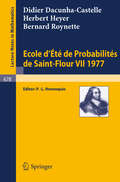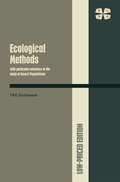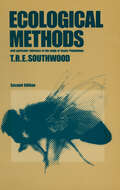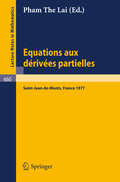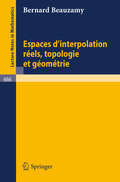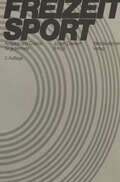- Table View
- List View
Differential Equations and Their Applications: An Introduction to Applied Mathematics (Applied Mathematical Sciences #15)
by M. BraunThis textbook is a unique blend of the theory of differential equations and their exciting application to "real world" problems. First, and foremost, it is a rigorous study of ordinary differential equations and can be fully un derstood by anyone who has completed one year of calculus. However, in addition to the traditional applications, it also contains many exciting "real life" problems. These applications are completely self contained. First, the problem to be solved is outlined clearly, and one or more differential equa tions are derived as a model for this problem. These equations are then solved, and the results are compared with real world data. The following applications are covered in this text. I. In Section 1.3 we prove that the beautiful painting "Disciples of Emmaus" which was bought by the Rembrandt Society of Belgium for $170,000 was a modem forgery. 2. In Section 1.5 we derive differential equations which govern the population growth of various species, and compare the results predicted by our models with the known values of the populations. 3. In Section 1.6 we derive differential equations which govern the rate at which farmers adopt new innovations. Surprisingly, these same differen tial equations govern the rate at which technological innovations are adopted in such diverse industries as coal, iron and steel, brewing, and railroads.
Differential Geometrical Methods in Mathematical Physics II: Proceedings, University of Bonn, July 13 - 16, 1977 (Lecture Notes in Mathematics #676)
by K. Bleuler H. R. Petry A. ReetzDifferential- und Integralrechnung II: Differentialrechnung in mehreren Veränderlichen Differentialgleichungen (Heidelberger Taschenbücher #36)
by H. Grauert W. FischerDifferentialgleichungen der Elektrotechnik: Lösung mittels Theorie der Differentialgleichungen, Laplace-Transformation und programmierbarer Taschenrechner
by Konrad Hoyer Gerhard SchnellDistributions and Nonlinear Partial Differential Equations (Lecture Notes in Mathematics #684)
by Elemer E. RosingerDynamic Programming and Its Applications: Proceedings of the International Conference on Dynamic Programming and Its Applications, University of British Columbia, Vancouver, British Columbia, Canada, April 14-16, 1977
by Martin L. PutermanDynamic Programming and Its Applications provides information pertinent to the theory and application of dynamic programming. This book presents the development and future directions for dynamic programming.Organized into four parts encompassing 23 chapters, this book begins with an overview of recurrence conditions for countable state Markov decision problems, which ensure that the optimal average reward exists and satisfies the functional equation of dynamic programming. This text then provides an extensive analysis of the theory of successive approximation for Markov decision problems. Other chapters consider the computational methods for deterministic, finite horizon problems, and present a unified and insightful presentation of several foundational questions. This book discusses as well the relationship between policy iteration and Newton's method. The final chapter deals with the main factors severely limiting the application of dynamic programming in practice.This book is a valuable resource for growth theorists, economists, biologists, mathematicians, and applied management scientists.
Ecole d'Ete de Probabilites de Saint-Flour VII, 1977 (Lecture Notes in Mathematics #678)
by D. Dacunha-Castelle H. Heyer B. RoynetteEcological Methods: With Particular Reference to the Study of Insect Populations
by T.R. Southwoodthe virtual impossibility of extracting the many different species from a habitat with equal efficiency by a single method (e.g. Nef, 1960). 1.1 Population estimates Population estimates can be classified into a number of different types; the most convenient classification is that adopted by Morris (1955), although he used the terms somewhat differently in a later paper (1960). 1.1.1 Absolute and related estimates The animal numbers may be expressed as a density per unit area of the ground of the habitat. Such estimates are given by nearest neighbour and related techniques (Chapter 2), marking and recapture (Chapter 3), by sampling a known fraction of the habitat (Chapter 4-6) and by removal sampling and random walk techniques (Chapter 7). Absolute population The number of animals per unit area (e.g. hectare, acre). It is almost impossible to construct a budget or to study mortality factors without the conversion of population estimates to absolute figures, for not only do insects often move from the plant to the soil at different developmental stages, but the amount of plant material is itself always changing. The importance of obtaining absolute estimates cannot be overemphasized.
Einführung in ALGOL 68: Skriptum für Hörer aller Fachrichtungen ab 1. Semester (uni-texte)
by Harry FeldmannEinführung in die Numerische Mathematik II: Unter Berücksichtigung von Vorlesungen von F.L. Bauer (Heidelberger Taschenbücher #114)
by J. Stoer R. BulirschElementare Wahrscheinlichkeitstheorie und stochastische Prozesse (Hochschultext)
by Kai L. ChungAus den Besprechungen: "Unter den zahlreichen Einführungen in die Wahrscheinlichkeitsrechnung bildet dieses Buch eine erfreuliche Ausnahme. Der Stil einer lebendigen Vorlesung ist über Niederschrift und Übersetzung hinweg erhalten geblieben. In jedes Kapitel wird sehr anschaulich eingeführt. Sinn und Nützlichkeit der mathematischen Formulierungen werden den Lesern nahegebracht. Die wichtigsten Zusammenhänge sind als mathematische Sätze klar formuliert." #FREQUENZ#1
Elements of Homotopy Theory (Graduate Texts in Mathematics #61)
by George W. WhiteheadAs the title suggests, this book is concerned with the elementary portion of the subject of homotopy theory. It is assumed that the reader is familiar with the fundamental group and with singular homology theory, including the Universal Coefficient and Kiinneth Theorems. Some acquaintance with manifolds and Poincare duality is desirable, but not essential. Anyone who has taught a course in algebraic topology is familiar with the fact that a formidable amount of technical machinery must be introduced and mastered before the simplest applications can be made. This phenomenon is also observable in the more advanced parts of the subject. I have attempted to short-circuit it by making maximal use of elementary methods. This approach entails a leisurely exposition in which brevity and perhaps elegance are sacrificed in favor of concreteness and ease of application. It is my hope that this approach will make homotopy theory accessible to workers in a wide range of other subjects-subjects in which its impact is beginning to be felt. It is a consequence of this approach that the order of development is to a certain extent historical. Indeed, if the order in which the results presented here does not strictly correspond to that in which they were discovered, it nevertheless does correspond to an order in which they might have been discovered had those of us who were working in the area been a little more perspicacious.
Elliptic Curves: Diophantine Analysis (Grundlehren der mathematischen Wissenschaften #231)
by S. LangIt is possible to write endlessly on elliptic curves. (This is not a threat.) We deal here with diophantine problems, and we lay the foundations, especially for the theory of integral points. We review briefly the analytic theory of the Weierstrass function, and then deal with the arithmetic aspects of the addition formula, over complete fields and over number fields, giving rise to the theory of the height and its quadraticity. We apply this to integral points, covering the inequalities of diophantine approximation both on the multiplicative group and on the elliptic curve directly. Thus the book splits naturally in two parts. The first part deals with the ordinary arithmetic of the elliptic curve: The transcendental parametrization, the p-adic parametrization, points of finite order and the group of rational points, and the reduction of certain diophantine problems by the theory of heights to diophantine inequalities involving logarithms. The second part deals with the proofs of selected inequalities, at least strong enough to obtain the finiteness of integral points.
Equations aux Derivees Partielles: Proceedings, Saint-Jean-de-Monts, June 1-4, 1977 (Lecture Notes in Mathematics #660)
by The Lai PhamEspaces d'interpolation reels, topologie et geometrie (Lecture Notes in Mathematics #666)
by B. BeauzamyFirst-Passage Percolation on the Square Lattice (Lecture Notes in Mathematics #671)
by R.T. Smythe J.C. WiermanFonctions de Plusieurs Variables Complexes III: Séminaire François Norguet Octobre 1975 - Juin 1977 (Lecture Notes in Mathematics #670)
by François NorguetFunctional Analysis (Grundlehren der mathematischen Wissenschaften #123)
by Kosaku YosidaThe present book is based on lectures given by the author at the University of Tokyo during the past ten years. It is intended as a textbook to be studied by students on their own or to be used in a course on Functional Analysis, i. e. , the general theory of linear operators in function spaces together with salient features of its application to diverse fields of modern and classical analysis. Necessary prerequisites for the reading of this book are summarized, with or without proof, in Chapter 0 under titles: Set Theory, Topo logical Spaces, Measure Spaces and Linear Spaces. Then, starting with the chapter on Semi-norms, a general theory of Banach and Hilbert spaces is presented in connection with the theory of generalized functions of S. L. SOBOLEV and L. SCHWARTZ. While the book is primarily addressed to graduate students, it is hoped it might prove useful to research mathe maticians, both pure and applied. The reader may pass, e. g. , from Chapter IX (Analytical Theory of Semi-groups) directly to Chapter XIII (Ergodic Theory and Diffusion Theory) and to Chapter XIV (Integration of the Equation of Evolution). Such materials as "Weak Topologies and Duality in Locally Convex Spaces" and "Nuclear Spaces" are presented in the form of the appendices to Chapter V and Chapter X, respectively. These might be skipped for the first reading by those who are interested rather in the application of linear operators.
Functions of One Complex Variable I (Graduate Texts in Mathematics #11)
by John B. Conway"This book presents a basic introduction to complex analysis in both an interesting and a rigorous manner. It contains enough material for a full year's course, and the choice of material treated is reasonably standard and should be satisfactory for most first courses in complex analysis. The approach to each topic appears to be carefully thought out both as to mathematical treatment and pedagogical presentation, and the end result is a very satisfactory book." --MATHSCINET
Functors and Categories of Banach Spaces: Tensor Products, Operator Ideals and Functors on Categories of Banach Spaces (Lecture Notes in Mathematics #651)
by P.W. MichorGaussian Random Processes (Stochastic Modelling and Applied Probability #9)
by I.A. Ibragimov Y.A. RozanovThe book deals mainly with three problems involving Gaussian stationary processes. The first problem consists of clarifying the conditions for mutual absolute continuity (equivalence) of probability distributions of a "random process segment" and of finding effective formulas for densities of the equiva lent distributions. Our second problem is to describe the classes of spectral measures corresponding in some sense to regular stationary processes (in par ticular, satisfying the well-known "strong mixing condition") as well as to describe the subclasses associated with "mixing rate". The third problem involves estimation of an unknown mean value of a random process, this random process being stationary except for its mean, i. e. , it is the problem of "distinguishing a signal from stationary noise". Furthermore, we give here auxiliary information (on distributions in Hilbert spaces, properties of sam ple functions, theorems on functions of a complex variable, etc. ). Since 1958 many mathematicians have studied the problem of equivalence of various infinite-dimensional Gaussian distributions (detailed and sys tematic presentation of the basic results can be found, for instance, in [23]). In this book we have considered Gaussian stationary processes and arrived, we believe, at rather definite solutions. The second problem mentioned above is closely related with problems involving ergodic theory of Gaussian dynamic systems as well as prediction theory of stationary processes.







